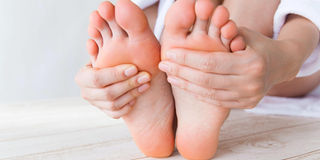Your cold hands and feet maybe a sign of underlying illness

Cold feet and hands could be a sign of underlying illness. PHOTO| FOTOSEARCH
What you need to know:
- When blood flow returns, you may notice pain, reddening and swelling of the toes or fingers. This reaction usually happens in response to cold, stress or anxiety.
Hello doctor,
I am 27 years. My hands and feet are always very cold even when the weather is hot. People always ask me why my hands are cold. I have to wear socks to find sleep at night and I even carry socks in my bag to wear in the office. When I don't wear socks, I get muscle cramps; my toes get stiff and I feel so much pain, I can barely walk. I usually try to ease the pain by pulling my toes and trying to massage them, but this doesn't help much - they only relax when they want to, after a few minutes. I often use a hot water bottle to warm my hands and feet, especially at night. Surprisingly, the rest of my body is usually warm. Is this normal and what can I do to fix it? Jen
Dear Jen,
What you are experiencing is called Raynaud’s phenomenon. What happens is that the “muscles” in your blood vessel walls contract or spasm and reduce blood flow to your hands and feet, making you feel cold, your skin may change colour to white or blue, and you may get numbness, pain or pins and needles in the affected areas. When blood flow returns, you may notice pain, reddening and swelling of the toes or fingers. This reaction usually happens in response to cold, stress or anxiety. Other parts of the body can be affected too.
Symptoms
The condition is more common in women, and affects between four and 20 per cent of adults. Most people begin to experience it while in their teens, 20s and 30s. There are two types – primary and secondary. Primary Raynaud’s is the most common type. It develops by itself with no known cause, and is usually not dangerous. The symptoms are more annoying, than serious, and they improve on their own. Secondary Raynaud’s occurs due to the presence of another illness, usually auto-immune disorders. These are illnesses where one’s own immune system attacks their own tissues leading to diseases like lupus, rheumatoid arthritis, systemic sclerosis or thyroid disease. Tests can be done to determine if you have primary or secondary Raynaud’s. Rarely, secondary Raynaud’s can lead to severe restriction of blood flow, leading to formation of ulcers, scars, darkening of the skin and even death of the tissue in the affected area (gangrene).
Some other factors that may trigger this include some medications (beta blockers, some cold medicines with pseudoephedrine, some chemotherapy drugs); repetitive use of the hands e.g. typing, playing piano, using hand tools; hand injuries, diseases of the arteries, where blockage is caused by plaque deposits; and smoking.
To manage the symptoms, avoid the cold, wear socks and gloves, run warm water over the affected area, stop smoking, reduce caffeine intake, take a hot meal or drink, exercise, and learn how to manage stress. It may take around 15 minutes to recover after you warm yourself. When the symptoms are severe, some medication can be used which help to relax the blood vessel walls e.g. nifedipine, a calcium channel blocker. If you have secondary Raynaud’s, then the underlying problem needs to be managed.
Dr Flo,
I have been struggling to treat persistent acne in face, chest and back but I failed. The one which stresses a lot is the one on the face. It has lowered my confidence and I no longer associate with others due it.
Mo
Dear Mo,
With acne, the pimples develop due to a combination of factors, which include hormonal changes (increased testosterone levels), infection and the amount of natural oily substance (sebum) produced by your skin. The pimples develop when hair follicles are blocked by sebum and dead cells. It is common during adolescence. The biggest problem with acne is aesthetic - how you look. The resulting pimples, white heads, black marks or scars are not pleasing to look at.
To manage acne, clean your face twice a day; in the morning, and in the evening before bed and shower after activities that make you sweat a lot. Use mild soap and a gentle towel. Do not scrub your face too much while cleaning it, since it is already sensitive. Take lots of water, and fruits and vegetables, and also exercise. Avoid skin products that are harsh and protect your skin from the sun. Avoid pressing the pimples, as this leads to developing black marks. Visit a dermatologist for advise on medications you can use to control the pimples. For many people it takes a while before you get medication that works for you specifically, so be patient.
My thighs often swell when they sweat. What could be the problem?
Ryan
Dear Ryan,
The swelling of the thighs when you sweat is most likely as a result of irritation and inflammation of the skin due to friction from whatever activity is generating the sweat like walking, running, cycling, other exercise or crossing your legs when sitting. It’s also more likely to happen if your thigh muscles are large, if you are overweight, if you wear tight or ill-fitting clothes, if you wear rough fabrics or after shaving.
To prevent this, apply Vaseline on the area, apply powder (cornstarch or baby powder), wear breathable fabric and loose underclothes and pants, keep yourself well hydrated, maintain a healthy weight, avoid crossing your legs when seated and consider applying anti-perspirant to your thighs. If there is itching, there are some ointments that can reduce the itching e.g. antihistamine or hydrocortisone ointments. If symptoms persist, please visit a dermatologist for review.
Send your questions to [email protected]

